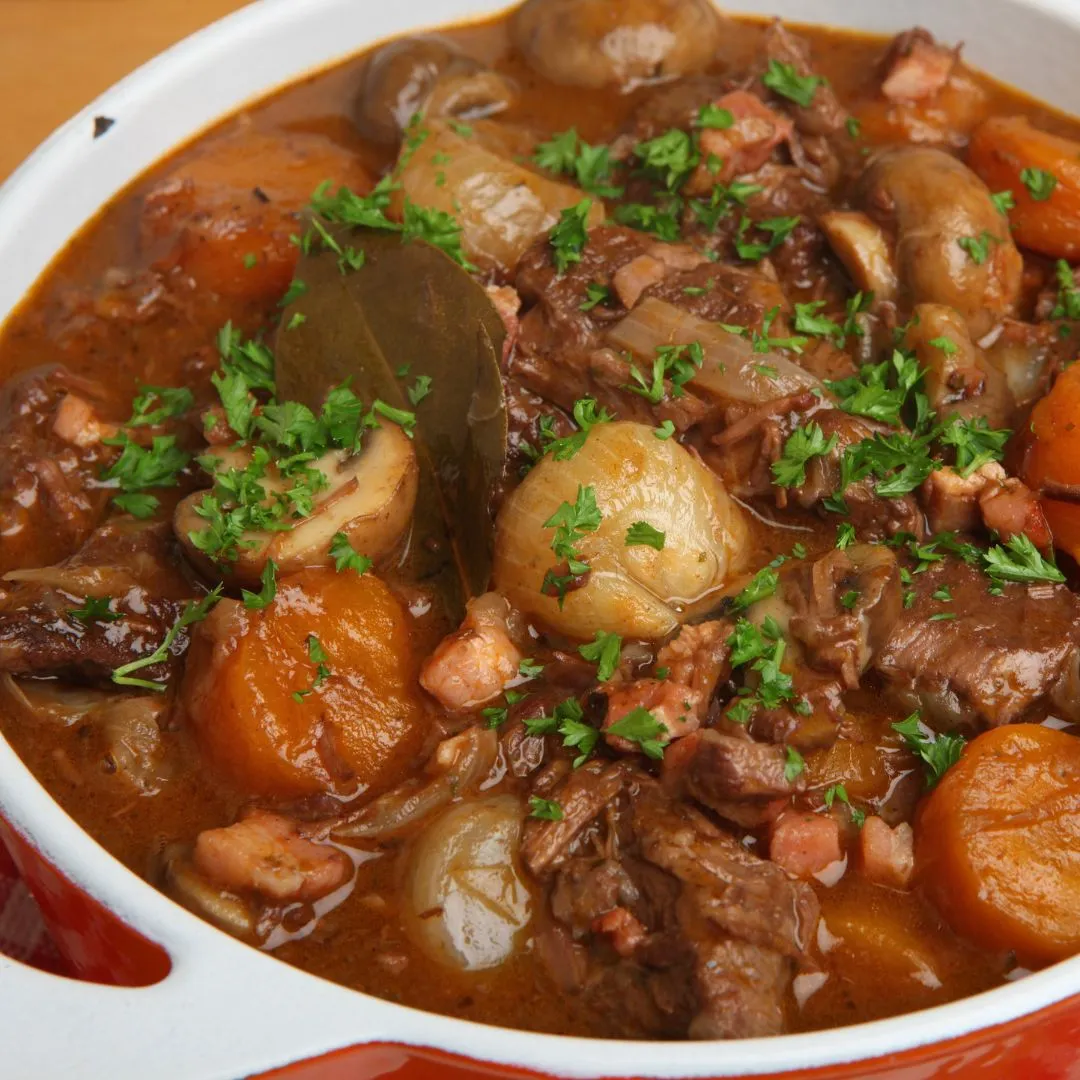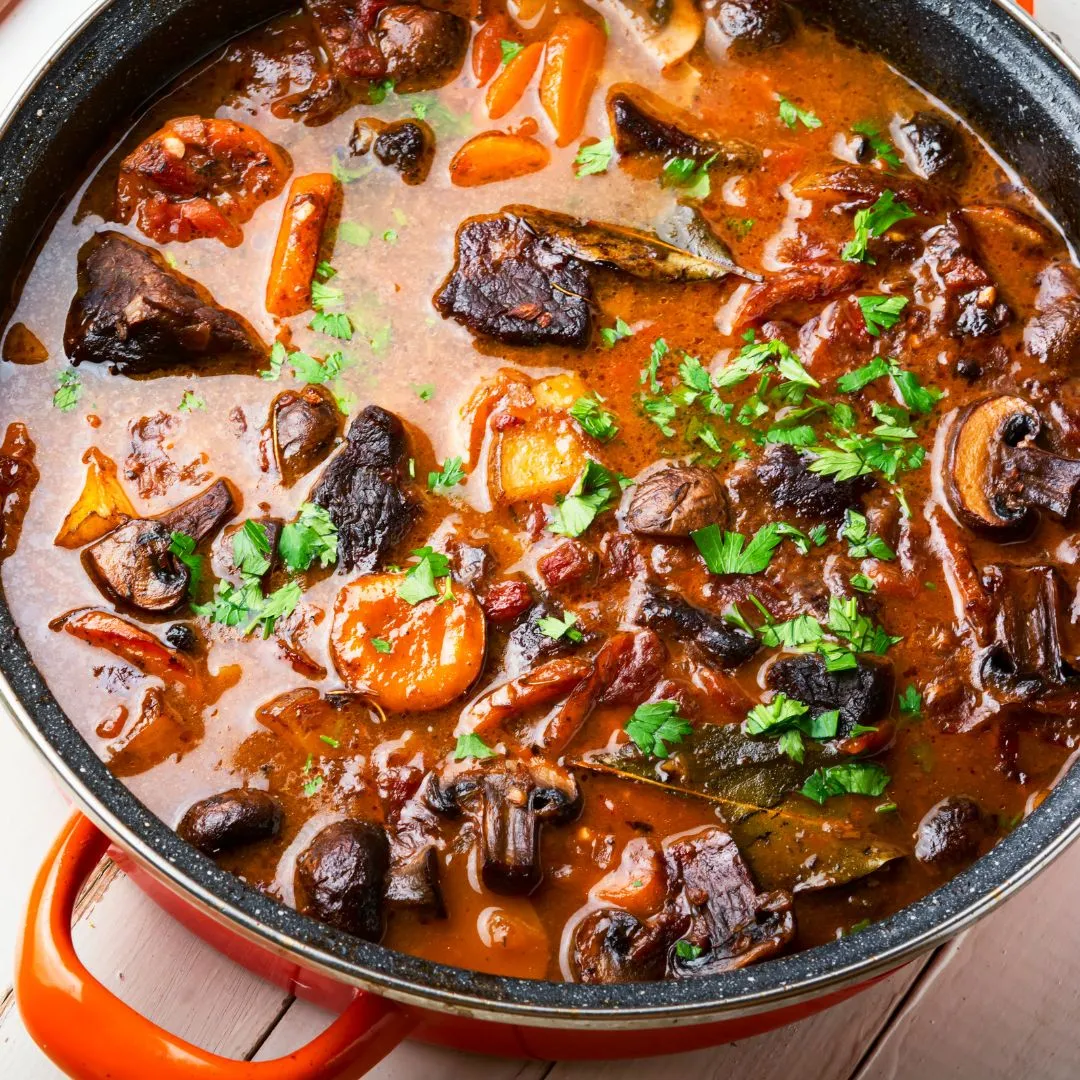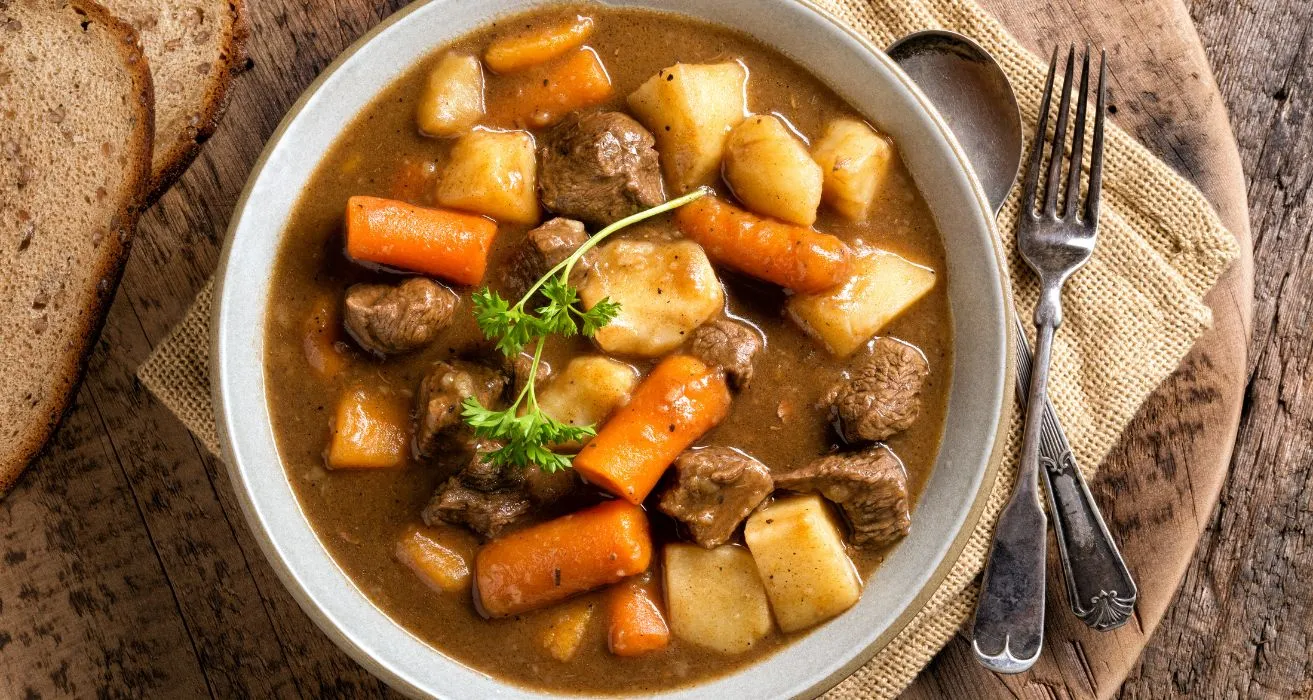Let’s embark on a culinary journey through the rustic and heartwarming world of cowboy stew. A dish steeped in history, cowboy stew embodies the essence of comfort food with its rich, hearty flavors and versatile ingredients. Perfect for those chilly nights or when you’re craving a taste of the American West, this stew is more than just a meal; it’s a hearty embrace in a bowl. As we delve into its origins, key components, and variations, you’ll discover not only how to make this delightful stew but also how to customize it to your taste. So, grab your Dutch oven, and let’s get cooking!
The Origins of Cowboy Stew
The tale of cowboy stew begins on the open ranges of the American West. Picture cowboys gathered around a campfire, stars twinkling overhead, as they share stories and enjoy a warm, filling stew made from whatever ingredients are on hand. This scene encapsulates the spirit of cowboy stew—a dish born out of necessity and resourcefulness, but rich in flavor and history. The stew was a way to feed a hungry crew with available meats, hearty vegetables, and beans, transforming simple ingredients into a delicious, energy-packed meal that could last for days on the trail.
Cowboy Stew in Modern Cuisine
Today, cowboy stew has ridden beyond the plains and into the hearts of home cooks everywhere. It’s celebrated for its robust flavors and adaptability to modern kitchens. No longer confined to chuck roast and beans, contemporary versions of cowboy stew embrace a variety of meats, legumes, and spices, making it a beloved comfort food classic for families around the globe. Plus, with the ease of slow cookers and Dutch ovens, anyone can whip up this one-pot wonder, bringing a taste of cowboy culture right to their table.
As we dive into this culinary adventure, remember, cowboy stew isn’t just about the ingredients; it’s about the memories and warmth shared with every spoonful. Whether you’re a seasoned chef or a curious novice, there’s a place for you by the cowboy stew pot, ready to savor a dish that’s as rich in history as it is in flavor. Stay tuned for our next section, where we’ll break down the core ingredients of this iconic stew, ensuring you have everything you need to bring this comforting classic to life in your own kitchen.
The Core Ingredients of Cowboy Stew
In crafting the heart of this rustic dish, understanding the core ingredients is essential. Let’s dive into the meat, vegetables, and seasonings that transform cowboy stew from a simple meal into a symphony of flavors.

Meat: The Heart of the Stew
At the core of every cowboy stew is a hearty meat that brings richness and depth. Chuck roast, known for its flavor and tenderness when slow-cooked, is a traditional choice. Braising this cut in a mix of spices and liquids turns it into a melt-in-your-mouth delight, embodying the stew’s essence. For a modern twist, consider using other braising meats like pork shoulder or even ground beef for a quicker cook time.
Vegetables and Legumes: Nutritional Powerhouses
Vegetables and legumes are more than just fillers; they’re the backbone of the stew’s nutritional profile. Potatoes, carrots, and onions offer essential vitamins and a natural sweetness that balances the meat’s savory notes. Beans, whether pinto, kidney, or black, add fiber and protein, making the stew a well-rounded meal. Don’t hesitate to throw in other hearty vegetables you have on hand—every addition makes the stew more your own.
Spices and Seasonings: Crafting the Unique Flavor
The final touch to any cowboy stew is the blend of spices and seasonings. Traditional salt and pepper lay the foundation, while additions like chili powder, cumin, and garlic powder bring warmth and complexity. For a hint of smoke and depth, consider a dash of smoked paprika or a chipotle pepper in adobo sauce. Remember, the key is to season gradually, tasting as you go, to build a flavor profile that’s robust yet balanced.
Incorporating these core components with care and creativity leads to a cowboy stew that’s not just a meal but a memorable experience. As you experiment with these ingredients, keep in mind the joy of cooking is in making each dish uniquely yours.
Stay tuned for our step-by-step cooking guide in the next section, where we’ll walk you through creating your own cowboy stew, ensuring a delicious result that warms the soul as much as the body. Whether you’re simmering your stew over a campfire or in your kitchen, the journey from pot to plate is one of love, tradition, and the simple pleasure of good food shared.
Remember, as you embark on this culinary adventure, you’re not just making a meal; you’re weaving a tale as rich and enduring as the cowboy spirit itself. Let’s get ready to stir up some history—one pot of cowboy stew at a time.
A Step-by-Step Cooking Guide
Creating a cowboy stew is much like weaving a tapestry, where each thread is an ingredient that contributes to the final masterpiece. Let’s break down the process into manageable steps, ensuring your stew is as flavorful as it is hearty.
Preparing Your Ingredients
The secret to a great stew starts long before the pot hits the stove. Begin by gathering your ingredients, focusing on the meats, vegetables, legumes, and spices that form the soul of your stew. For meat, cutting your chuck roast or chosen protein into bite-sized pieces ensures even cooking and easy eating. Chop your vegetables into uniform pieces to promote consistent texture. If you’re using beans, rinse them thoroughly to remove any excess sodium or preservatives.
Ingredients you will need:
Before you start cooking, gather all the necessary ingredients for your cowboy stew. Here’s what you’ll need:
- 1 lb of chuck roast or ground beef, cut into bite-sized pieces
- 1 can (15 oz) of beans (pinto, kidney, or black beans), rinsed and drained
- 1 can (15 oz) of corn, drained
- 1 can (15 oz) of diced tomatoes
- 1 medium onion, chopped
- 1 bell pepper, diced
- 2 cloves of garlic, minced
- 4 cups of beef broth
- 1 tablespoon of chili powder
- 1 teaspoon of cumin
- Salt and pepper to taste
- Optional: 1 tablespoon of cornstarch mixed with 2 tablespoons of water to thicken the stew
With these ingredients prepped and ready, you’re set to begin cooking your cowboy stew. This selection ensures a rich, flavorful dish, embodying the spirit of the West with every spoonful. Remember, cooking is an art, so feel free to adjust the quantities or ingredients based on your preferences and dietary needs. Let’s get ready to bring this comforting classic to life in your kitchen.
The Cooking Process: Tips and Tricks
With your ingredients prepped, it’s time to start cooking. Here’s a step-by-step guide to bringing your cowboy stew to life:
- Brown Your Meat: In a large Dutch oven or pot, heat a splash of oil over medium-high heat. Add your meat in batches, ensuring not to overcrowd the pot. Browning the meat adds a deep, savory flavor base that’s essential for a rich stew.
- Sauté the Vegetables: Once the meat is browned and set aside, in the same pot, add your onions, carrots, and other vegetables. Sauté until they begin to soften and pick up a slight golden color, adding garlic towards the end to prevent burning.
- Deglaze and Simmer: Return the meat to the pot with your vegetables. Add enough broth to cover the ingredients, scraping up any browned bits from the bottom of the pot for extra flavor. Bring to a boil, then reduce the heat to a simmer. This slow cooking process is crucial for tenderizing the meat and melding flavors.
- Seasoning: Now’s the time to add your spices—chili powder, cumin, salt, and pepper. Remember, the stew’s magic lies in its seasoning, so adjust according to your taste, adding more spices as needed.
- Final Touches: After the stew has simmered and the ingredients are tender, it’s time for the final adjustments. Taste and season as necessary. If you prefer a thicker stew, you can mix a small amount of cornstarch with water and add it to the pot, simmering until the desired consistency is reached.
- Let It Rest: One of the most overlooked steps in making stew is allowing it to rest off the heat for a few minutes before serving. This resting period lets the flavors deepen and meld together even further.
Adjusting the Flavor to Your Taste
The beauty of cowboy stew lies in its flexibility. Feel free to experiment with the spices and seasonings, adding a personal touch to the dish. Some might enjoy a spicier stew with extra chili powder or fresh chilies, while others might prefer a more aromatic version with bay leaves or thyme. The stew is your canvas, and the seasonings are your palette.
Crafting the perfect cowboy stew is a journey of flavors, textures, and aromas that culminate in a dish that’s both comforting and satisfying. Whether you’re a novice cook or a seasoned chef, the process of making cowboy stew offers a chance to experiment, learn, and ultimately create a meal that warms the heart and fills the belly.
Stay tuned for our exploration of the different variations of cowboy stew in the next section. From traditional recipes passed down through generations to modern adaptations that cater to various dietary preferences, we’ll discover how this versatile dish can be tailored to suit any taste or occasion.
Variations of Cowboy Stew
The essence of cowboy stew lies in its adaptability, making it a perfect canvas for culinary creativity. Let’s delve into how this dish can be modified to cater to a range of preferences, ensuring everyone can enjoy a bowl of this comforting classic.

Traditional vs. Modern Adaptations
The traditional cowboy stew, rooted in the simplicity of meat, beans, and vegetables, has undergone numerous transformations. Today, modern adaptations incorporate a variety of ingredients such as sweet potatoes, corn, and even beer for depth of flavor. These additions reflect contemporary tastes and the fusion of culinary cultures, showcasing the stew’s ability to adapt over time.
Vegetarian and Vegan Versions of Cowboy Stew
Embracing a plant-based diet doesn’t mean missing out on the heartiness of cowboy stew. By substituting meat with robust alternatives like lentils, chickpeas, or textured vegetable protein, you can still capture the stew’s essence. Mushrooms, with their meaty texture and umami flavor, also make an excellent addition, offering a satisfying depth that appeals to vegetarians and meat-eaters alike.
In these vegetarian and vegan versions, the richness of the stew comes from the blend of spices and the variety of vegetables used. Smoked paprika, cumin, and chili powder can still play their roles in adding warmth and complexity to the dish, ensuring that the stew remains a comforting and flavorful option for all.
Serving and Pairing Suggestions
Pair your cowboy stew with perfect sides and drinks for an unforgettable meal. Enjoy it with cornbread or biscuits. They’re great for soaking up the broth. A green salad adds freshness, balancing the stew’s heartiness.
Choose a full-bodied red wine or dark beer to enhance the flavors. For a non-alcoholic choice, try spiced apple cider or black tea. They add a cozy touch, echoing the stew’s warmth.
Our cowboy stew journey shows its timeless appeal and flexibility. Whether sticking to tradition or adding new twists, this stew unites people. It’s all about sharing and making lasting memories.
Next, we’ll explore the nutritional benefits of cowboy stew. This will highlight how it fits into a healthy lifestyle.
Nutritional Information and Health Benefits
In this section of your cowboy stew journey, it’s time to ladle out the facts on its nutritional content and health benefits. Cowboy stew isn’t just a feast for the senses; it’s also packed with ingredients that can contribute positively to your diet. Here’s how you could structure this informative piece.
A Closer Look at What’s in Your Bowl
Start by breaking down the stew into its core components: the meats, vegetables, and legumes. For each ingredient, highlight the essential nutrients it brings to the table, such as protein from the meat, fiber from the beans, and vitamins and minerals from the vegetables. Discuss how these nutrients contribute to overall health, emphasizing aspects like heart health, energy levels, and immune system support.
Nutritional Breakdown of Cowboy Stew
Offer a detailed nutritional analysis of a standard serving of cowboy stew. This could include calorie count, macronutrients (proteins, fats, and carbohydrates), and key vitamins and minerals. Use this information to discuss how cowboy stew can fit into various dietary needs, whether someone is looking for high-protein meals, low-fat options, or meals rich in specific nutrients like iron or vitamin A.
Health Benefits of Regular Ingredients
Elaborate on how regular consumption of the ingredients found in cowboy stew can contribute to long-term health benefits. For example, you might explore how lean beef can support muscle growth and maintenance, how beans can improve digestive health, and how the antioxidants in vegetables can combat inflammation.
This section provides a fantastic opportunity to debunk myths about hearty dishes like cowboy stew being unhealthy. By focusing on the quality of ingredients and the balance of nutrients, you can present cowboy stew as not only a delicious meal choice but also a healthy one.
Throughout this section, remember to use transition words generously to ensure smooth flow and maintain reader engagement. Keep your sentences concise and lively, peppered with idioms and colloquial expressions to keep the tone friendly and accessible.
And there you have it! With this approach, you’ll not only share the delights of cowboy stew but also educate your readers on its nutritional value, making it a dish they can enjoy both heartily and guilt-free. Stay tuned for more insights and tips on bringing the best out of your culinary adventures.
FAQs
In this section, address common questions readers might have about cowboy stew, making your article not only informative but also interactive. Here’s a suggested structure:
What is cowboy stew made of?
Cowboy stew is a hearty mix of ground beef or chuck roast, beans, corn, tomatoes, onions, and bell peppers. Seasoned with a blend of spices, it’s a flavorful, comforting dish. Every ingredient contributes to its robust flavor, making it a favorite.
How do you thicken cowboy stew?
To thicken cowboy stew, you can use cornstarch or flour mixed with water. Stir this mixture into the stew and simmer. Within minutes, the stew will thicken beautifully. It’s a simple yet effective way to reach the desired consistency.
Is beef stew a healthy meal?
Yes, beef stew can be a healthy meal. It’s packed with protein, vitamins, and minerals from its meat and vegetable content. Opting for lean cuts of meat and plenty of vegetables enhances its nutritional value. Plus, it’s a warm, satisfying dish.
What are the best cuts of meat for cowboy stew?
Explain why chuck roast is favored for its flavor and tenderness when slow-cooked but also suggest alternatives like pork shoulder or even venison for a wild game twist. Emphasize the importance of choosing meats that benefit from long, slow cooking to become tender and flavorful.
Can cowboy stew be made in a slow cooker?
Offer tips for adapting the recipe to a slow cooker, highlighting the convenience and ease of this method. Include a brief guide on adjustments for cooking times and liquid ratios to ensure a successful slow cooker version of the stew.
How can I make cowboy stew vegetarian?
Suggest substitutes for the meat component, such as lentils, mushrooms, or plant-based meat alternatives. Emphasize the versatility of the stew and encourage readers to experiment with various protein sources to cater to their dietary preferences.
What are the best spices for cowboy stew?
Discuss the traditional spices used in cowboy stew and their roles in flavoring the dish. Encourage readers to personalize their stew with spice blends that reflect their taste preferences, perhaps suggesting a few unusual spices to experiment with for those looking to explore new flavors.
